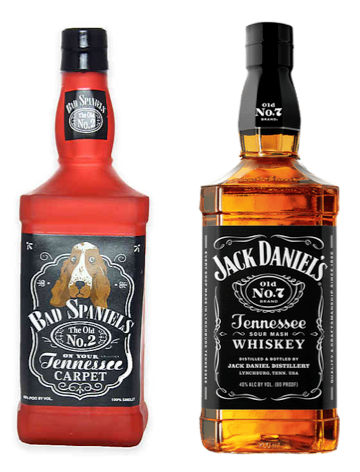2021 Intellectual Property Primer: Cases to Watch this Year
The United States Supreme Court has a full docket of intellectual property cases before it in 2021. The Court is expected to make a number of rulings and decisions that are likely to impact the future landscape of trademark, copyright and patent law.
Trademarks
Expressive Humor and Brand Tarnishment: Jack Daniel’s has asked the Supreme Court to overturn a Ninth Circuit ruling that a poop-themed parody dog toy (pictured below) was an expressive work and, therefore, subject to First Amendment protection.
 In essence, the Ninth Circuit ruled that a commercial product’s use of Jack Daniel’s registered marks was a noncommercial use under the Lanham Act because the parody dog toy used the marks in a humorous manner. Accordingly, Jack Daniel’s claim of dilution by tarnishment was not actionable because the poop-themed dog toy did not use Jack Daniel’s marks in a commercial manner.
In essence, the Ninth Circuit ruled that a commercial product’s use of Jack Daniel’s registered marks was a noncommercial use under the Lanham Act because the parody dog toy used the marks in a humorous manner. Accordingly, Jack Daniel’s claim of dilution by tarnishment was not actionable because the poop-themed dog toy did not use Jack Daniel’s marks in a commercial manner.
The case, and the Supreme Court’s decision to hear it or not, will be of significant importance to companies with established brands, as well as those companies looking to parody well-known brands for their own commercial success.
Copyrights
Copyright’s Fair Use Doctrine: A hold over from the 2020 addition of this alert, the Court will issue its ruling in Google v. Oracle later this year after hearing oral arguments last year. The case is the culmination of a decade’s worth of litigation involving two of world’s largest tech companies.
Oracle has accused Google of stealing copyrighted pieces of Java source code for use in Google’s Android smartphones. Google has argued that the Java software language Oracle accuses it of stealing is: (1) too functional to be protected by copyright law; and (2) is subject to copyright’s fair use doctrine.
The Supreme Court is expected to rule on both issues. The ruling will be particularly noteworthy because the Court has never issued binding precedent related to the copyrightability of source code and it has not issued a fair use decision in over twenty-five years.
Copyrightability of Fictional Characters: The Supreme Court will determine early this year whether to hear the case of The Moodsters Company v. Walt Disney, which asks the Court to articulate the proper standard for determining the copyrightability of a fictional or animated character.
The Copyright Act does not specifically identify animated characters as protectable subject matter, but every circuit court to address the question has found animated characters to be protectable as components of audiovisual or literary works. However, these same courts disagree on the standard an animated character must meet to qualify for copyright protection.
The Petitioner has asked the Supreme Court to adopt an originality standard, which would be satisfied if the artist expresses the original work in a fixed medium.
Patents
Constitutionality of Patent Trial and Appeal Board Judges: The case of U.S. v. Arthrex Inc. is the main attraction of the 2021 Supreme Court term for patent practitioners and constitutional scholars alike. The general issue is whether Patent Trial and Appeal Board Judges must be appointed by the President with the advice and consent of the United States Senate or if they are “inferior officers” whose appointment Congress has properly vested in the head of the USPTO.
Practically speaking, the outcome has the potential to turn the current system on its head and effectively eliminate inter partes review (IPR) for an extended period. IPRs are an effective and regular tool of patent litigation. Their elimination, even for a short period, would drastically influence patent litigation strategy. However, the range of potential outcomes in this case is vast, ranging from a complete overhaul of the current system by Congress to a mere continuation of the status quo.
Applicability of the Doctrine of Assignor Estoppel: Later this month, the Supreme Court will consider whether to grant certiorari in Minerva Surgical Inv. v. Hologic Inc. on an issue involving the scope of the doctrine of assignor estoppel. In general, the doctrine bars an inventor who sells or assigns its rights in the invention to another from challenging the validity of a patent covering the inventor’s invention. Both sides in this case have petitioned the Court to hear the case with one party arguing that the doctrine should be abolished, while the other argues that its scope should be enlarged to cover proceedings before the Patent Trial and Appeals Board. Currently, the doctrine is only applicable in litigation before the federal courts.
Patent Eligibility: After rejecting a number of cases regarding patent eligibility in 2020, the Supreme Court will once again be asked in 2021 to revisit and clarify its prior rulings. It is anticipated that the Court will be asked to resolve the case of American Axle & Manufacturing Inc. v. Neapco Holdings LLC after the Federal Circuit declined to hear the case en banc in a divided 6-6 vote. That 6-6 vote follows the Federal Circuit’s 2019 ruling that American Axle & Manufacturing’s method to reduce noise and vibrations through the insertion of a liner in its driveshaft was not eligible for patent protection because the process amounted to nothing more than an application of natural law to a complex system.
The Supreme Court’s rulings in Mayo v. Prometheus in 2012 and Alice v. CLS Bank in 2014—which collectively held that laws of nature and abstract ideas are not eligible for patent protection—have been a source of confusion and frustration for inventors, practitioners, and judges alike.
Quantity and Enablement: Indenix Pharmaceuticals LLC has petitioned the Supreme Court to reverse the Federal Circuit’s affirmation of a district court’s ruling that its patent was invalid because it did not enable a person skilled in the art to make or use the invention. The patent at issue involves a genus claim—routinely found in pharmaceutical patents—which the Federal Circuit concluded did not meet the enablement requirement as a matter of law because it contained too many compounds. Not only is the question presented in Indenix Pharmaceuticals LLC v. Gilead Sciences Inc. an interesting issue with implications for patent litigation strategy, generally, but the case is particularly noteworthy because it involves the reversal of a $2.54 billion jury verdict in Indenix’s favor, which, if restored, would be the largest patent verdict in U.S. history.
Please contact your Vorys attorney if you have any questions about the impact any of these cases has on your intellectual property portfolio or litigation strategy.




